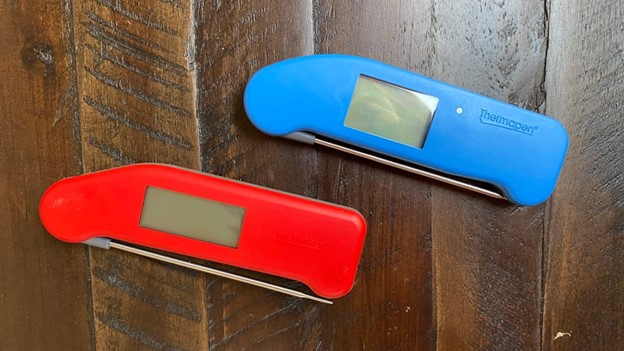America’s Test Kitchen Pros Share Tips for a PERFECT Steak!
Meat-lovers of the world all agree, in terms of pulling off a restaurant-worthy meal in less time than it takes to drive to a restaurant, not much beats a perfectly home-seared steak. Nice steaks aren’t cheap, though, so to make sure you get your money’s worth, you’ll want to guarantee that it’s cooked to perfection (whether grilled or pan-seared).

Since I’ve ruined a lot of steaks in my career, I’m always looking for help to improve my searing skills. Maybe you can relate? If so, we’re all in luck, because last week Jessica Rudolph, reported from America’s Test Kitchen on how to KNOW when our steak is truly done, along with other Test Kitchen tried-and-true tricks to ensure perfectly cooked steaks. Here’s what she had to say:
The first piece of advice from the Test Kitchen experts is to use an Instant-Read Thermometer. “It’s most important tool in a meat-cooker’s arsenal. Following a recipe’s timing and heat level will get you most of the way to a perfectly cooked steak, but in order to navigate variations in stove output, skillet material, and steak thickness, the precision of an instant-read thermometer is paramount. (The test kitchen’s favorite is the ThermoWorks Thermapen ONE.)”

Before I share more of Jessica’s reporting, let’s talk about this highly recommended tool. A digital meat thermometer tells you when your meats have reached the optimal tenderness, and can also help you adhere to FDA food safety guidelines. The Thermapen One is the latest version of professional chefs’ favorite brand.
The One may be one of the most advanced digital meat thermometers you can buy. The battery-powered device boasts a more than 2,000-hour work time with one AAA 1.5-volt battery, which is plenty of time considering you only need a few seconds to get the temperature readings with each use.

USA Today reviews products and like America’s Test Kitchen, they were highly impressed with this thermometer: “This new thermometer has a lot in common with its predecessor, the MK4, such as the display that can rotate 360° and full water-proofing. The major difference between the two is speed and precision. While the MK4 has one of the fastest temperature readings at just four seconds, the One promises readings in one second. And, the One has improved its accuracy from ±0.7°F to ±0.5°F, which may be the most precise measurement available for home cooking.
“To accurately take the temperature of a steak, lift it with tongs and insert the thermometer probe through its side (aiming for the center of the thickest part if the steak is uneven). Pull your steak off the heat when it’s 120 degrees (for rare), 125 degrees (for medium-rare), or 135 degrees (for medium)—the temperature will continue to climb about 5 degrees as it rests.”

While it’s true that you can learn to tell how cooked a steak is by pressing it with your fingertip, this method takes a lot of trial and error to accurately calibrate your squish-o-meter. The bottom line—why risk it?
Now back to the rest of the Test Kitchen’s steak advice: Second only to using a meat thermometer is letting your cooked steak rest. “That rest is another important aspect of steak cookery. Besides providing a convenient window to finish your side dishes, resting also gives the muscle fibers time to relax and reabsorb any released moisture, ensuring the juiciest end result.
“Rest your steaks on a wire rack (not the typical cutting board) so that the gorgeously browned crust you worked for won’t steam and go soggy. Tent the steak with aluminum foil to retain some heat but still allow steam to escape.”

And here’s the biggie: DON’T TOUCH IT for 10 minutes. A tough challenge, yes, but we can do this if it means a perfect steak!

Since I’ve ruined a lot of steaks in my career, I’m always looking for help to improve my searing skills. Maybe you can relate? If so, we’re all in luck, because last week Jessica Rudolph, reported from America’s Test Kitchen on how to KNOW when our steak is truly done, along with other Test Kitchen tried-and-true tricks to ensure perfectly cooked steaks. Here’s what she had to say:
The first piece of advice from the Test Kitchen experts is to use an Instant-Read Thermometer. “It’s most important tool in a meat-cooker’s arsenal. Following a recipe’s timing and heat level will get you most of the way to a perfectly cooked steak, but in order to navigate variations in stove output, skillet material, and steak thickness, the precision of an instant-read thermometer is paramount. (The test kitchen’s favorite is the ThermoWorks Thermapen ONE.)”

Before I share more of Jessica’s reporting, let’s talk about this highly recommended tool. A digital meat thermometer tells you when your meats have reached the optimal tenderness, and can also help you adhere to FDA food safety guidelines. The Thermapen One is the latest version of professional chefs’ favorite brand.
The One may be one of the most advanced digital meat thermometers you can buy. The battery-powered device boasts a more than 2,000-hour work time with one AAA 1.5-volt battery, which is plenty of time considering you only need a few seconds to get the temperature readings with each use.

USA Today reviews products and like America’s Test Kitchen, they were highly impressed with this thermometer: “This new thermometer has a lot in common with its predecessor, the MK4, such as the display that can rotate 360° and full water-proofing. The major difference between the two is speed and precision. While the MK4 has one of the fastest temperature readings at just four seconds, the One promises readings in one second. And, the One has improved its accuracy from ±0.7°F to ±0.5°F, which may be the most precise measurement available for home cooking.
“To accurately take the temperature of a steak, lift it with tongs and insert the thermometer probe through its side (aiming for the center of the thickest part if the steak is uneven). Pull your steak off the heat when it’s 120 degrees (for rare), 125 degrees (for medium-rare), or 135 degrees (for medium)—the temperature will continue to climb about 5 degrees as it rests.”

While it’s true that you can learn to tell how cooked a steak is by pressing it with your fingertip, this method takes a lot of trial and error to accurately calibrate your squish-o-meter. The bottom line—why risk it?
Now back to the rest of the Test Kitchen’s steak advice: Second only to using a meat thermometer is letting your cooked steak rest. “That rest is another important aspect of steak cookery. Besides providing a convenient window to finish your side dishes, resting also gives the muscle fibers time to relax and reabsorb any released moisture, ensuring the juiciest end result.
“Rest your steaks on a wire rack (not the typical cutting board) so that the gorgeously browned crust you worked for won’t steam and go soggy. Tent the steak with aluminum foil to retain some heat but still allow steam to escape.”

And here’s the biggie: DON’T TOUCH IT for 10 minutes. A tough challenge, yes, but we can do this if it means a perfect steak!
 Alice Osborne
Alice Osborne
Weekly Newsletter Contributor since 2006
Email the author! alice@dvo.com
